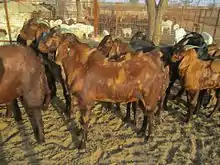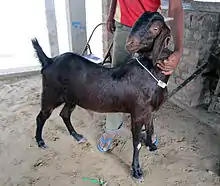Sirohi goat
The Sirohi goat is a dual-purpose compact, medium to large sized goat breed reared for both meat and milk production. This goat is named after its actual breeding tract, Sirohi district of Rajasthan, India. It is believed to have been developed by the Raika community of Rajasthan which is long been associated with the development of many other livestock breeds.


Distribution
The original breeding tract of Sirohi goat is Sirohi district of Rajasthan. Now it is expanded to Ajmer, Nagaur, Tonk, Sikar, Jhunjhunu, Chitorgarh, Udaipur, Rajsamand, Bhilwara, Jaipur and other districts of Rajasthan, even in adjoining regions of northern Gujarat. The population density of the breed is higher in the Aravalli Range. This breed is so popular that it is gradually extending to the areas of other states adjoining Rajasthan like Gujarat, Uttar Pradesh, Madhya Pradesh and Haryana. As per the 18th livestock census, some animals of this breed are also available in southern states of Karnataka and Kerala.
Description
Body size: Sirohi goats are medium to large sized animals with compact cylindrical to conical body. Generally, cylindrical shaped animals are believed to be better meat producers while animals with conical body are considered good in milk production. Some adult animals may have a depression in the thoracic region, giving a saddle back appearance. The body is covered with fairly dense hair which is short and coarse. Coat colour: Prominent colours are brown and brown with light to dark brown patches (spotted brown). Both, brown and spotted brown types are generally available in three shades of dark, medium and light. Very few animals are completely white. The body coat is generally shiny in nature, but some animals possess hairy coat also. Face: Face of Sirohi goat is generally straight or sometimes slightly raised. Ear: Ears are generally flat and leaf like, medium-sized and drooping type. They are described as pendulous, drooping downwards, leaf-like in shape with slight curvature towards back. Horn: Both males and females have horns which are generally curved upward and backward with pointed tips; but other horn patterns are also seen. Some Sirohi animals without horn (polled) are also found. Tail: Tail is small to medium in length and curved upward. Wattles and beard: Some Sirohi animals have two wattles hanging from the neck and beard under the lower jaw. Indo-Swiss Goat Project (ISGP) study reported that wattles were present in about 30% of animals. True beard are also present in few animals. Udder conformation: Udder is small and round, with small teats placed laterally. Some (6%) of the goats registered under the Indo-Swiss Goat Project (ISGP scheme were reported to have supernumerary teats. [1]
Alternate names
The breed is also known by other names such as Devgarhi, Parbatsari, and Ajmeri.
Population
As per Breed survey, 2013 (DAHDF, 2014), India has a total Sirohi goat population of about 3.08 million, majority of which are found in Rajasthan only.
Breeding
Sirohi goats can be bred throughout the year, but major breeding season in semi-arid region of Rajasthan is May to July and corresponding kidding season is October to December. In the organized government farm under AICRP on goat improvement scheme located at Central Sheep & Wool Research Institute (CSWRI), Avikanagar, Rajasthan, India, selective breeding is practised in Sirohi goats through hand mating. For keeping Sirohi goats for meat purpose, the males can initially be selected based on 3 month body weight, then on 6 or 9 month body weight. For dual purpose (meat and milk) animals, males can be selected based on a combined score of animal's body weight at 6 or 9 month and dam's 1st lactation 3 month milk yield. The female stock can be pre-selected on 3 month's weight, followed by body weight at 6 or 9 month of age, then its 1st lactation milk yield.
As livestock
Sirohi goats are dual-purpose animals, being reared for both milk and meat. The animals are popular for their weight gain and lactation even under poor quality rearing conditions. The animals are resistant to major diseases and are easily adaptable to different climatic conditions. Though the main breeding tracts of Sirohi goats are situated in the Aravalli hills of Rajasthan, they are also widely distributed in several other Indian states.[2] On average, 90% of all births will result in a single kid with the remaining 10% producing twins. Lactation can last for up to 90 days and average to 0.75–1 kg/day for a good does.
Meat Production
Sirohi goat is the most profitable recognized goat breed of India because this breed gains bodyweight quickly as compared to other breeds on normal feeding, that's why it is considered best meat production for any goat breed. The birth weight of Sirohi goat kid is 3.5 to 4 kg and it achieves easily 12 kg body weight at the age of 3 months after that it gains 5 kg every month on normal feeding.
References
- "sheep and goat breeds of india". Fao.org. Retrieved 29 November 2018.
- "Rearing Sirohi goats ideal for small scale farmers". Thehindu.com. 1 June 2006. Retrieved 29 November 2018.